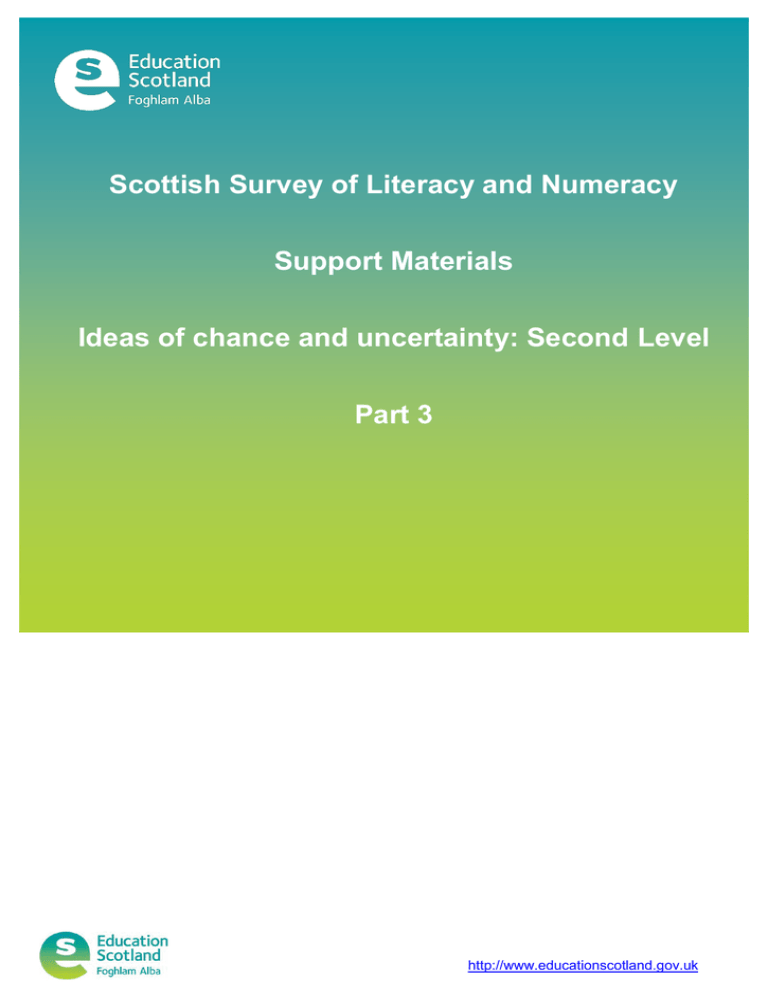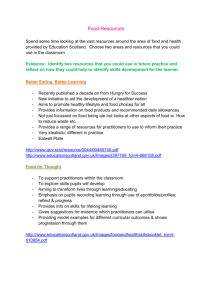Scottish Survey of Literacy and Numeracy Support Materials
advertisement

Scottish Survey of Literacy and Numeracy Support Materials Ideas of chance and uncertainty: Second Level Part 3 http://www.educationscotland.gov.uk Second Level: Ideas of Chance and Uncertainty Experience and Outcome: MNU 2-22 I can conduct simple experiments involving chance and communicate my predictions and findings using the vocabulary of probability. Learning Intention I will carry out an experiment and record the results. I will use known facts to predict the outcome of my experiment Success Criteria I can choose a suitable experiment to carry out. I can record the results accurately. Through investigation, I can begin to estimate probability. I can begin to predict results with increased confidence. I can begin to predict a pattern based on the results of my experiment. Key Vocabulary: Certain , impossible, likely, likelihood, unlikely, very unlikely, how likely, very likely, highly unlikely, highly likely, chance, good chance, poor chance, evens, probability, scale, even chance, fair, unfair, fifty –fifty, equal chance, percentage chance, one in two, two in three etc http://www.educationscotland.gov.uk Learning and Teaching Ideas and possible contexts Dicey Dice Cover a die to make three yellow faces and three red faces. Roll it 20 times and record the results. What happened? Repeat, using four red faces and two yellow faces. What happens now? Can you predict what happens when the die has five red faces and one yellow face. Repeat the above experiment with a die with three different coloured faces. Heads or Tails. Pupils each have a whiteboard or discs with H (for heads) on one side and T (for tails) on the other side. All pupils stand and are asked to predict what happens when a coin is tossed. They hold up their predictions and the coin is then tossed. Those who have guessed correctly remain standing and the rest sit down. Play continues until all pupils are seated. This can be played a few times and pupils asked to explain any strategies they might be using. The game can then be adapted to play with two coins. Following this pupils carry out their own coin tossing experiment and record their results. In addition they can conduct a two coin tossing experiment and record their results. Discussion can take place based on their results. How likely is it to toss two coins and both land on Tails? What is the most likely outcome? Is tossing a Tail then a Head the same as tossing a Head, then a Tail? http://www.mathsonline.co.uk/nonmembers/resource/prob/ (coin toss simulation) What happens to the height of the bars in the simulated experiment? What happens when you increase the number of trials? In the Bag (Sampling) Bags for each group are prepared beforehand with cubes of three different colours in the ratio 6:3:1 e.g. 6 blue, 3 red and 1 green. Pupils are told there are 10 cubes in the bag. In their groups they take turns to pick a cube from the bag, record the colour and return the cube to the bag. After ten turns, the group then try to predict the number of each coloured cube in the bag. Continue sampling for another ten turns and ask the group if they would like to change their prediction. Groups then check their predictions with the actual number of coloured cubes in the bag. The task can be adapted by changing the ratio of colours, or by getting groups to make up bags for another group to carry out the sampling task. Red cube 6 Blue Cube 3 Green cube 1 http://www.transum.org/Software/SW/Starter_of_the_day/starter_March18.ASP (as above, demonstrated visually) *Reflective questions: Is it possible to start with experiments and then explore vocabulary and numerical representations of probability? What other experiments could we use? Are there some experiments that could support a science project? How well do pupils understand the link between probability and predictions? What can you do to support them explore their understanding of these connections? Cross curricular contexts for Learning *Reflective questions How does ‘ideas of chance and uncertainty’ contribute to the development of skills for learning, life and work? Reflecting on your curriculum plan, where do you see possible links with other curricular areas? http://www.educationscotland.gov.uk Planning for progression http://www.youtube.com/watch?v=tyX79mPm2xY (Johnny Ball demonstrating the use of sampling to predict the number of taxis in London) This could be extended to looking at the environment and how this technique is used to monitor numbers of fish in the sea. Pupils could carry out a beach / street / school clean up and see if their predictions are accurate. http://www.educationscotland.gov.uk



